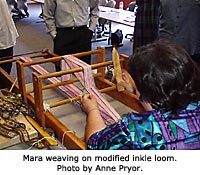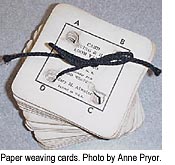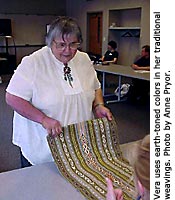Home | Search | The Artists | Teaching | Hiring | About This Site | Contact Us


Vera and Mara’s
Art Form

Latvian Weaving
Warrens, WI
The Basics
Have you ever woven? Weaving can be a simple or a highly complex art. Before
we learn more about Latvian styles, let’s learn the basics of weaving.
 Weavers
must have two sets of threads, warp threads and weft threads. The threads that a
weaver secures lengthwise or vertically
to an object, like a loom,
are the warp
threads. In the picture above, the warp threads are almost all the threads you
see. The threads a weaver pulls under and over the
Weavers
must have two sets of threads, warp threads and weft threads. The threads that a
weaver secures lengthwise or vertically
to an object, like a loom,
are the warp
threads. In the picture above, the warp threads are almost all the threads you
see. The threads a weaver pulls under and over the ![]() warp
are called the weft.
warp
are called the weft.
Look at the above picture again. What do you think Mara does with the piece of wood she is holding in her right hand? Mara uses this weaving knife to press the weft threads close together, so they are tight and even. A tight and even weave is an important aesthetic quality to Vera and Mara.
Cards and Looms
 Vera
and Mara use a variety of techniques when they weave. They use looms for wide
items, like table clothes, curtains, blankets, and material for skirting, pants
and shirts. They use card weaving to make narrow
and highly decorative
items, like belts and the trim
for skirts and hats.
Vera
and Mara use a variety of techniques when they weave. They use looms for wide
items, like table clothes, curtains, blankets, and material for skirting, pants
and shirts. They use card weaving to make narrow
and highly decorative
items, like belts and the trim
for skirts and hats.
Vera learned how to do loom weaving from her mom. Vera and Mara own several looms: one 16-harness loom and two 12-harness looms. The more harnesses a loom has, the more complicated designs a weaver can create. Weaving with sixteen harnesses is considered very advanced.
Vera’s mom Emma didn’t know much about card weaving. Vera took that up on her own. When Vera and Mara card weave, they use two tools: 1) square shaped, four-holed weaving cards and 2) a small, modified inkle loom that their neighbor made. Some weavers secure the ends of their weaving to a chair or a doorknob to give it tension. Vera and Mara use an inkle loom for that purpose. Card weaving has been around for about 2,000 years. Ancient “cards” were made of stone and wood. Vera and Mara use sturdy paper cards, like the ones in the above photo.
Vera describes card weaving like this, “It is a mixture of rope twisting and weaving. You have a card with four holes. Every hole has a thread through it, so you have four threads. Every time you turn the card a quarter of a turn, you are twisting the four threads into a rope—twisting away from you. Every time there is a twist in the rope, a connecting weft thread holds them together.”
See how it’s done—watch Vera card weave! You can read along by clicking here.
Nature’s Role
 Symbols
are a common and important aspect of many traditional art forms. Symbols can be
colors, patterns, or designs. Have you ever seen symbols used in art? Have you
ever included symbols in your own art work? Sometimes symbols aren’t
recognized by people outside of the ethnic, cultural, or regional community that
creates or uses them. Once you understand the symbols in Vera and Mara’s
weavings, you will know more about the what messages the weavings hold.
Symbols
are a common and important aspect of many traditional art forms. Symbols can be
colors, patterns, or designs. Have you ever seen symbols used in art? Have you
ever included symbols in your own art work? Sometimes symbols aren’t
recognized by people outside of the ethnic, cultural, or regional community that
creates or uses them. Once you understand the symbols in Vera and Mara’s
weavings, you will know more about the what messages the weavings hold.
Agriculture and nature play an important role in Latvian folklife—just like they play an important role in Wisconsin folklife. Some of the most important symbols in Latvian weaving are related to nature. Here are a few.
 The
Swastika (sometimes called a Luck Cross or Thunder Cross) stands for luck, among
other positive wishes. In early agricultural times, luck was an important factor
in the quality of a harvest.
The
Swastika (sometimes called a Luck Cross or Thunder Cross) stands for luck, among
other positive wishes. In early agricultural times, luck was an important factor
in the quality of a harvest.
 The
Sun symbolizes a part of nature that is very important in traditional Latvian
beliefs. The sun provides energy for all living things.
The
Sun symbolizes a part of nature that is very important in traditional Latvian
beliefs. The sun provides energy for all living things.
 The
Star symbol also represents an important part of nature for traditional
Latvians.
The
Star symbol also represents an important part of nature for traditional
Latvians.
 The
Garden symbol is often used to connected other symbols in weavings.
The
Garden symbol is often used to connected other symbols in weavings.

 Toads
and salamanders are abundant in Vera’s home country. The symbol on the left is
“Mara’s Toad.” Mara is an earth and fertility goddess in Latvia. The
Salamander symbol is on the right. These reptiles show up in Vera and Mara’s
weavings too!
Toads
and salamanders are abundant in Vera’s home country. The symbol on the left is
“Mara’s Toad.” Mara is an earth and fertility goddess in Latvia. The
Salamander symbol is on the right. These reptiles show up in Vera and Mara’s
weavings too!
All of these symbols are used in various forms in Latvian weavings. Sometimes half of a symbol decorates the border of a skirt or shawl. They can take many different forms and come in many different colors.
Colors play an important role in Vera and Mara’s weavings. When you look at their weavings, you’ll notice that many of them have greens and browns. Most of the colors they use are colors that come from natural dyes, made from plants found in Eastern Europe. These types of colors are traditionally used in weavings from Vera’s family’s region, central Latvia. When Vera and Mara use natural dye colors, it represents central Latvia’s connections to the land and products from the land.

For Educators:
“It’s a rather intricate thing.”
– Vera Mednis
Home | Search | The Artists | Teaching | Hiring | About This Site | Contact Us